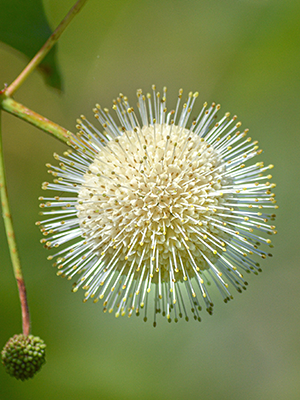
by Sheila Dunning | Jun 23, 2022
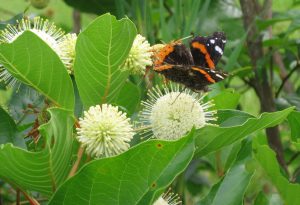 Beginning in 2007 the US Senate, in support of the North American Pollinator Protection Campaign, declared the last week of June as “National Pollinator Week.” As humans, we depend on pollen-moving animals for one out of every three bites of food. Without birds, bees, bats, beetles, butterflies, and various other animals, many flowers would fail to reproduce. In Florida there are numerous native plants that serve as hosts for these pollinators.
Beginning in 2007 the US Senate, in support of the North American Pollinator Protection Campaign, declared the last week of June as “National Pollinator Week.” As humans, we depend on pollen-moving animals for one out of every three bites of food. Without birds, bees, bats, beetles, butterflies, and various other animals, many flowers would fail to reproduce. In Florida there are numerous native plants that serve as hosts for these pollinators.
One of the favorites, due to its heavy flowering over the summer, is Buttonbush (Cephalanthus occidentalis). 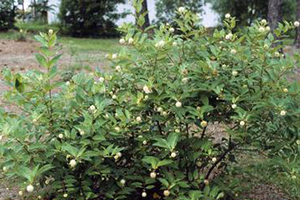 It is a semi-aquatic woody shrub to small tree that develops white golf-ball-sized clusters of fragrant flowers, attracting various pollinating animals. Bees of various species, several different wasps, assorted moths and butterflies, flies and even hummingbirds scramble for the flowers’ sweet treat within each of the trumpet shaped flowers. The pincushion-like flower balls stand on two inch stalks in clusters arising from stem tips and leaf axils. They are produced over a long period in late spring and summer. The flowers give way to little reddish-brown nutlets which persist on the through the winter. Buttonbush seeds are important wildlife food, especially for ducks; and the dense, impenetrable tickets provide nesting and escape cover for many wetland birds and herptiles. Buttonbush is a fast-growing wetland plant that can be grown in a naturalized landscape if given supplemental water during dry spells. It is at its best, through, in an area where the soil is frequently wet and can tolerate soggy soils. Buttonbush is not drought or salt tolerant. The deciduous shrub grows well in full sun to partial shade on soils that are acidic to slightly alkaline. The leaves of Buttonbush turn yellow in the fall before dropping off. While short-lived, requiring rejuvenation pruning to improve its longevity, Buttonbush (Cephalanthus occidentalis) serves a critical role to wildlife in the wetland habitat. Deer browse the foliage and twigs. Ducks, especially the mallard, eat the seeds. And, the summer flowers attract bees, butterflies and moths; our wonderful pollinators.
It is a semi-aquatic woody shrub to small tree that develops white golf-ball-sized clusters of fragrant flowers, attracting various pollinating animals. Bees of various species, several different wasps, assorted moths and butterflies, flies and even hummingbirds scramble for the flowers’ sweet treat within each of the trumpet shaped flowers. The pincushion-like flower balls stand on two inch stalks in clusters arising from stem tips and leaf axils. They are produced over a long period in late spring and summer. The flowers give way to little reddish-brown nutlets which persist on the through the winter. Buttonbush seeds are important wildlife food, especially for ducks; and the dense, impenetrable tickets provide nesting and escape cover for many wetland birds and herptiles. Buttonbush is a fast-growing wetland plant that can be grown in a naturalized landscape if given supplemental water during dry spells. It is at its best, through, in an area where the soil is frequently wet and can tolerate soggy soils. Buttonbush is not drought or salt tolerant. The deciduous shrub grows well in full sun to partial shade on soils that are acidic to slightly alkaline. The leaves of Buttonbush turn yellow in the fall before dropping off. While short-lived, requiring rejuvenation pruning to improve its longevity, Buttonbush (Cephalanthus occidentalis) serves a critical role to wildlife in the wetland habitat. Deer browse the foliage and twigs. Ducks, especially the mallard, eat the seeds. And, the summer flowers attract bees, butterflies and moths; our wonderful pollinators.

by Laura Tiu | Dec 2, 2021
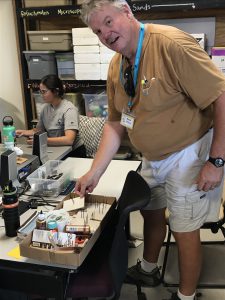
Florida Master Naturalist Student and Florida State Park Ranger, Bruce Williams, prepares for his snowy plover lesson.
There is an oft quoted proverb “those who can’t do, teach.” It is meant to be humorous, but it couldn’t be farther from the truth. Teachers of all kinds have enormous impacts on our lives. For graduates of the Florida Master Naturalist Program (FMNP) there is a line in the mission statement that reads “The FMNP teaches those who teach others about Florida’s unique ecosystems and wildlife.” In fact, to graduate, FMNP students must complete a project and present, or teach, it to the class.
A good teacher, like a good entertainer first must hold his audience’s attention, then he can teach his lesson (John Henrik Clarke). In a recent coastal class, we had the good fortune of having a State Park Ranger as a student. His job requires him to do interpretive education at the park, so he had quite a bit of experience under his belt. His project, a craft project involving the assembly of a cute snowy plover chick, was his way of holding his audience’s attention while he talked of the importance of preserving and protecting habitat for shorebirds.
I thought the project and message was impressive and worthy of sharing. To all of you teachers out there who work to make our lives and world better, thank you, and here is another great activity to add to your quiver. If you would like more information on the Florida Master Naturalist Program go here: https://masternaturalist.ifas.ufl.edu.
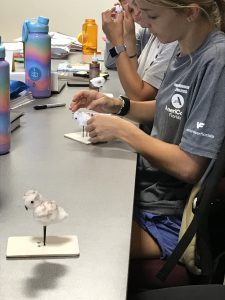
Making cotton ball snowy plover chicks
Group Project: Make a Snowy Plover Chick (Peipert, 2011)
This project is suitable for Elementary age through Middle school age children. It is recommended when doing project with a class or large group that some preparation is done ahead of time.
Supplies:
corrugated cardboard (disassembled brown packing box will do)
1 bag of cotton balls
1 container of black glass beads (sold at craft stores)
black sunflower seeds
1 container of wood toothpicks (kind with one end blunt)
1 can of black spray paint
several of each black, brown & gray markers
several bottles of quick dry tacky glue (sold at craft stores)
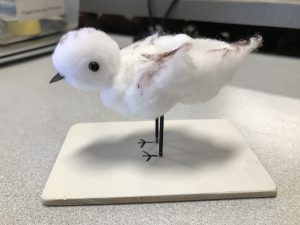
Cotton ball snowy plover chick craft
Preparation:
- Using an exacto or carpet knife and T-square cut corrugated cardboard into 3”x3” squares for the # of stands needed. To complete stand preparation, write Snowy Plover chick on stand, draw a pair of feet in center of stand and pierce cardboard in center of feet. This step is a real time saver and recommended for young children.
- Paint toothpicks with black spray paint for legs, easiest way to do this is by taking toothpicks and sticking them into a spare piece of cardboard upright them paint.
Instructions: (skip to instruction #3 if using stands with feet & holes premade)
- Draw a pair of bird feet on center of cardboard and if you want write” Snowy Plover chick” on cardboard.
- Use the pointed end of a toothpick to make a hole in the center of drawn feet. Then put the blunt end of toothpicks in the holes and put a heavy glob of glue around them. Don’t be shy with the glue, it will dry clear and will be better support.
- Take one of the cotton balls and roll around between hands to make it smaller. This will be the head. Next using all three or two markers make many dots on one side of both cotton balls creating a speckled pattern.
- Put a glob of glue at top of each toothpick and put larger cotton ball (the body) on top of toothpicks pushing down so the glue is covered by the cotton ball. Next put a glob of glue on the top of body and put white side of cotton ball (the head) on glue.
- To complete the chick put a small glob of glue on opposite sides of head then place glass beads on. Lastly put a glob of glue on side of head that the feet are facing forward and place sunflower seed on with the pointed end facing out.
- Let stand for at least 15 minutes to dry before handling.
- Enjoy your Snowy Plover chick creation!
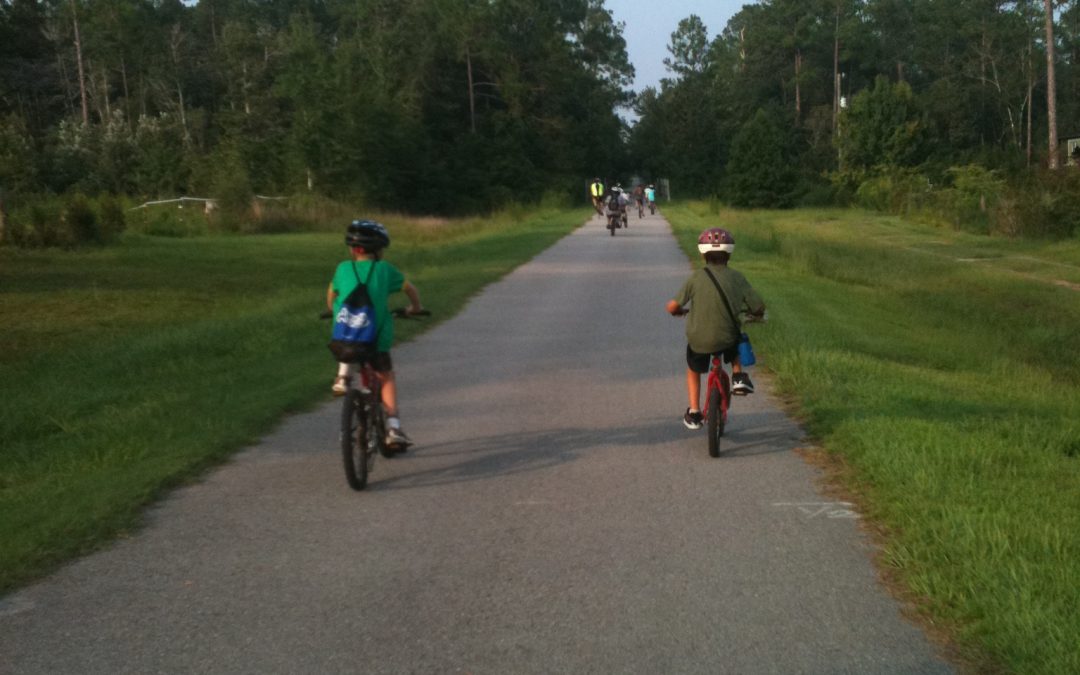
by Carrie Stevenson | May 29, 2020
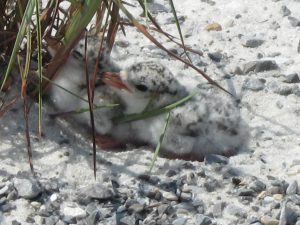
Baby terns on Pensacola Beach are camouflaged in plain sight on the sand. This coloration protects them from predators but can also make them vulnerable to people walking through nesting areas. Photo credit: UF IFAS Extension
The controversial incident recently in New York between a birdwatcher and a dog owner got me thinking about outdoor ethics. Most of us are familiar with the “leave no trace” principles of “taking only photographs and leaving only footprints.” This concept is vital to keeping our natural places beautiful, clean, and safe. However, there are several other matters of ethics and courtesy one should consider when spending time outdoors.
- On our Gulf beaches in the summer, sea turtles and shorebirds are nesting. The presence of this type of wildlife is an integral part of why people want to visit our shores—to see animals they can’t see at home, and to know there’s a place in the world where this natural beauty exists. Bird and turtle eggs are fragile, and the newly hatched young are extremely vulnerable. Signage is up all over, so please observe speed limits, avoid marked nesting areas, and don’t feed or chase birds. Flying away from a perceived predator expends unnecessary energy that birds need to care for young, find food, and avoid other threats.
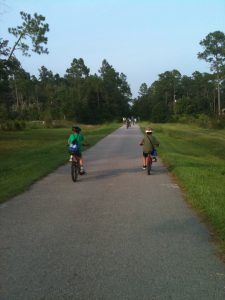
When on a multi-use trail, it is important to use common courtesy to prevent accidents. Photo credit: Carrie Stevenson, UF IFAS Extension
- On a trail, the rules of thumb are these: hikers yield to equestrians, cyclists yield to all other users, and anyone on a trail should announce themselves when passing another person from behind.
- Obey leash laws, and keep your leash short when approaching someone else to prevent unwanted encounters between pets, wildlife, or other people. Keep in mind that some dogs frighten easily and respond aggressively regardless of how well-trained your dog is. In addition, young children or adults with physical limitations can be knocked down by an overly friendly pet.
- Keep plenty of space between your group and others when visiting parks and beaches. This not only abides by current health recommendations, but also allows for privacy, quiet, and avoidance of physically disturbing others with a stray ball or Frisbee.
Summer is beautiful in northwest Florida, and we welcome visitors from all over the world. Common courtesy will help make everyone’s experience enjoyable.
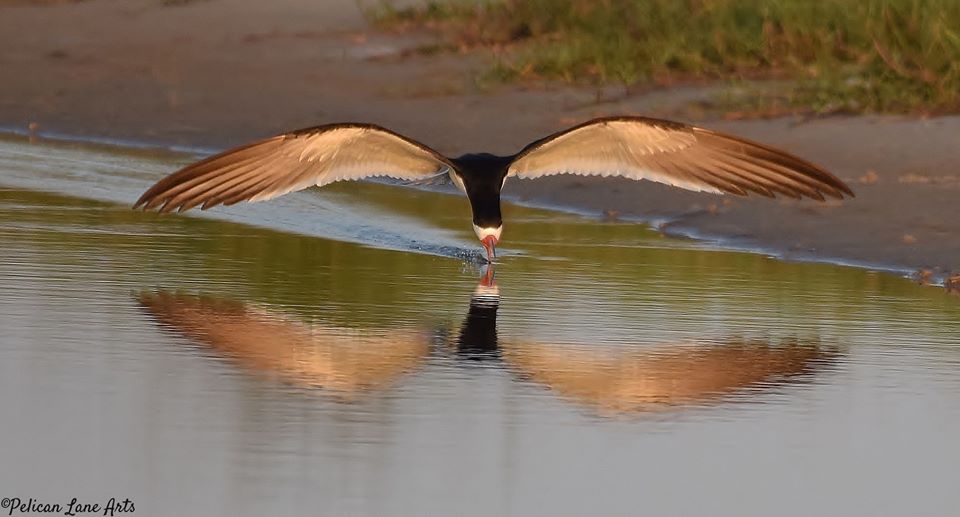
by Chris Verlinde | May 1, 2020
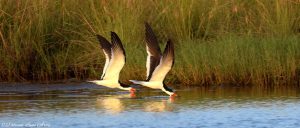
Black Skimmers foraging for fish. Photo Credit: Jan Trzepacz, Pelican Lane Arts.
Black Skimmers and Least Terns, state listed species of seabirds, have returned along the coastal areas of the northern Gulf of Mexico! These colorful, dynamic birds are fun to watch, which can be done without disturbing the them.
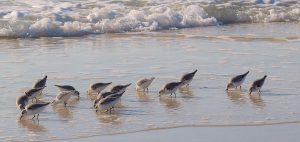
Shorebirds foraging. Photo Credit: Jan Trzepacz, Pelican Lane Arts.
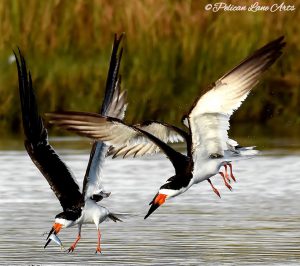
Black Skimmer with a fish. Photo Credit: Jan Trzepacz, Pelican Lane Arts.
What is the difference between a seabird and shorebird?
Among other behaviors, their foraging habits are the easiest way to distinguish between the two. The seabirds depend on the open water to forage on fish and small invertebrates. The shorebirds are the camouflaged birds that can found along the shore, using their specialized beaks to poke in the sandy areas to forage for invertebrates.
Both seabirds and shorebirds nest on our local beaches, spoil islands, and artificial habitats such as gravel rooftops. Many of these birds are listed as endangered or threatened species by state and federal agencies.
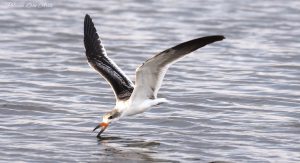
Juvenile Black Skimmer learning to forage. Photo Credit: Jan Trzepacz, Pelican Lane Arts.
Adult black skimmers are easily identified by their long, black and orange bills, black upper body and white underside. They are most active in the early morning and evening while feeding. You can watch them swoop and skim along the water at many locations along the Gulf Coast. Watch for their tell-tale skimming as they skim the surface of the water with their beaks open, foraging for small fish and invertebrates. The lower mandible (beak) is longer than the upper mandible, this adaptation allows these birds to be efficient at catching their prey.
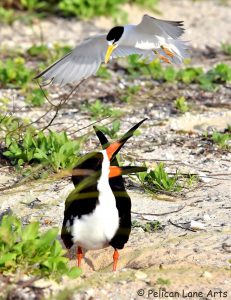
Least Tern “dive bombing” a Black Skimmer that is too close to the Least Tern nest. Photo Credit: Jan Trzepacz, Pelican Lane Arts.
Adult breeding least terns are much smaller birds with a white underside and a grey-upper body. Their bill is yellow, they have a white forehead and a black stripe across their eyes. Just above the tail feathers, there are two dark primary feathers that appear to look like a black tip at the back end of the bird. Terns feed by diving down to the water to grab their prey. They also use this “dive-bombing” technique to ward off predators, pets and humans from their nests, eggs and chicks.
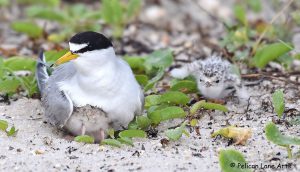
Least Tern with chicks. Photo Credit: Jan Trzepacz, Pelican Lane Arts.
Both Black Skimmers and Least Terns nest in colonies, which means they nest with many other birds. Black skimmers and Least Terns nest in sandy areas along the beach. They create a “scrape” in the sand. The birds lay their eggs in the shallow depression, the eggs blend into the beach sand and are very hard to see by humans and predators. In order to avoid disturbing the birds when they are sitting on their nests, known nesting areas are temporarily roped off by Audubon and/or Florida Fish and Wildlife Conservation Commission (FWC) representatives. This is done to protect the birds while they are nesting, caring for the babies and as the babies begin to learn to fly and forage for themselves.
Threats to these beautiful acrobats include loss of habitat, which means less space for the birds to rest, nest and forage. Disturbances from human caused activities such as:
- walking through nesting grounds
- allowing pets to run off-leash in nesting areas
- feral cats and other predators
- litter
- driving on the beach
- fireworks and other loud noises
Audubon and FWC rope-off nesting areas to protect the birds, their eggs and chicks. These nesting areas have signage asking visitors to stay out of nesting zones, so the chicks have a better chance of surviving. When a bird is disturbed off their nest, there is increased vulnerability to predators, heat and the parents may not return to the nest.
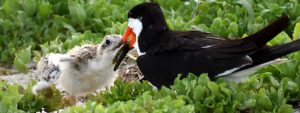
Black Skimmer feeding a chick. Photo Credit: Jan Trzepacz, Pelican Lane Arts.
To observe these birds, stay a safe distance away, zoom in with a telescope, phone, camera or binoculars, you may see a fluffy little chick! Let’s all work to give the birds some space.
Special thanks to Jan Trzepacz of Pelican Lane Arts for the use of these beautiful photos.
To learn about the Audubon Shorebird program on Navarre Beach, FL check out the Relax on Navarre Beach Facebook webinar presentation by Caroline Stahala, Audubon Western Florida Panhandle Shorebird Program Coordinator:
In some areas these birds nest close to the road. These areas have temporarily reduced speed limits, please drive the speed limit to avoid hitting a chick. If you are interested in receiving a “chick magnet” for your car, 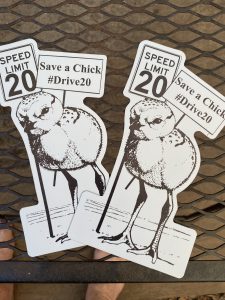 to show you support bird conservation, please send an email to: chrismv@ufl.edu, Please put “chick magnet” in the subject line. Please allow 2 weeks to receive your magnet in the mail. Limited quantities available.
to show you support bird conservation, please send an email to: chrismv@ufl.edu, Please put “chick magnet” in the subject line. Please allow 2 weeks to receive your magnet in the mail. Limited quantities available.
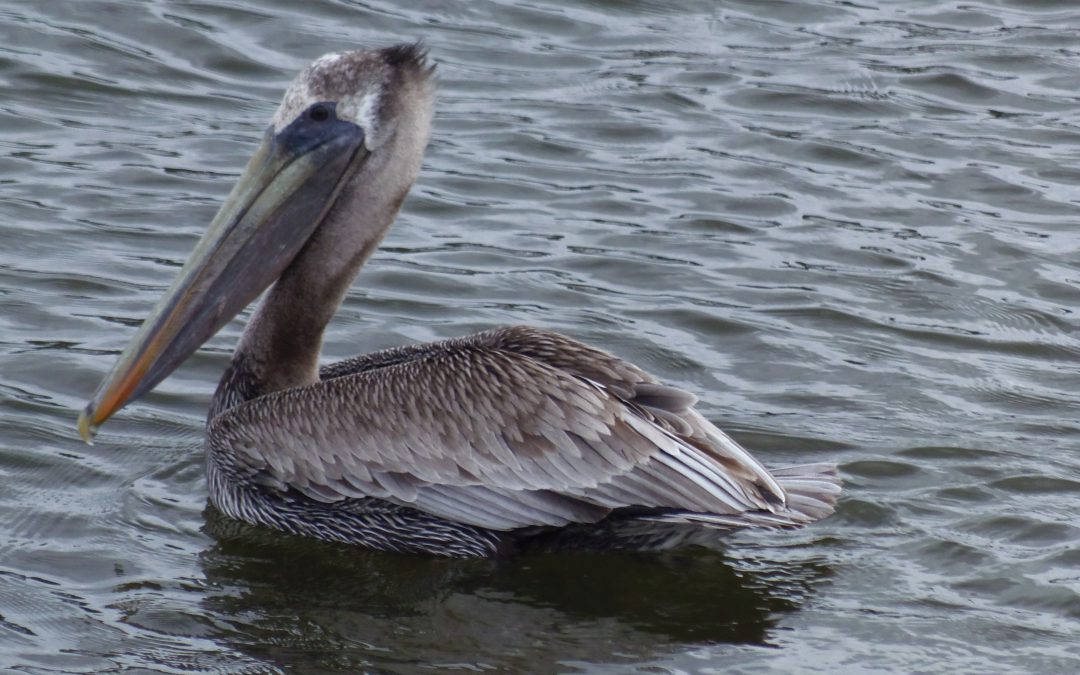
by Rick O'Connor | Feb 21, 2020
The birds…
This is nuts… an article about the birds of the Gulf of Mexico in 500 words or less… right.
Do you know how many species of birds live in and around the Gulf?
It’s a lot…
Birds have the fewest barriers, and the widest range of just about any animal on the planet. They can easily fly over deserts, mountains, and oceans. Most of us have seen gulls in every parking lot in the United States, and we know that many species intentionally migrate over these large landscapes.
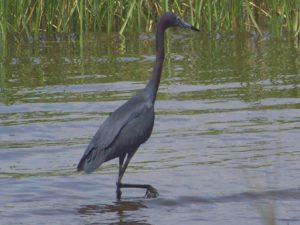
This little blue heron is stalking prey in a Gulf coast salt marsh.
Photo: Molly O’Connor
So, we are going to focus here on just “seabirds”. But how do you define a “seabird”? An ornithologist I worked with many years ago told me – “if it eats seafood… it’s a seabird”. I do not know if all ornithologists would agree with this, but this is what we are going with.
On our barrier islands we find mockingbirds, cardinals, and many other “woodland” birds. Since they do not eat “seafood”, we will not include them here. I have seen seabirds grouped into (a) offshore birds, (b) nearshore birds, and (c) shorebirds. Offshore birds would be those that spend most of their lives on the wing, in flight over open water. Nearshore birds are those that leave land when the sun rises for a day at sea, but eventually return that evening. And shorebirds are near the beach all the time.
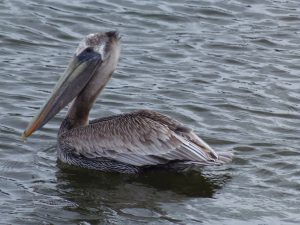
Though still uncommon in some parts of the Gulf, the brown pelican is a very recognizable bird along our shores.
Photo: Molly O’Connor
I used an old bird guide to make a list of such birds that have been found in the Gulf region. As many of you know, some are only seasonal. Published in 1980, Roger Tory Peterson’s Birds of the Eastern United States list 94 “seabirds” that are either full time, or part time, residents of the Gulf. Most (92%) are shorebirds.
This guide suggests there are six species of offshore seabirds that visit the Gulf region. These species have long tapered wings and can remain aloft for hours or days. Many have special glands on their beaks to excrete salt, since they would have to swallow seawater if at sea for a long time. Shearwaters and petrels have been recorded over the southern Gulf. The northern Gannet (which prefers the arctic region) has been reported over the northern Gulf. Two species of boobies have been reported as well.
I was only able to find one record of a “nearshore seabird” and that is the Magnificent Frigate bird, also known as the “Man-o-War” bird. It gets its common name from its habitat of “pirating” food from other seabirds. It can catch food on its own but seems to enjoy stealing from others. They can be seen nearshore on very windy days high above sorrowing almost still with their “bent” wing design. In the southern Gulf they nest on mangrove islands and locals there see them on a regular basis.
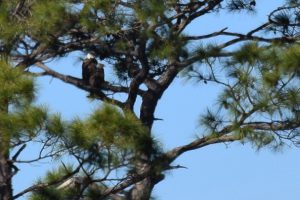
Bald eagles are becoming more common along the Gulf coast.
Photo: Charles Pulley
Based on this guide, there are 87 species of shorebirds in the Gulf region, 59 only winter here. The list is huge and includes loons and cormorants, pelicans and herons, gulls and terns, and the stilt legged birds such as herons and egrets. Many hunters await one of 19 species of duck that spend winter here and in recent years encounters with bald eagles have increased.
Birds lack teeth so they must either grab, or cut, their prey with their bills. Members of the pelican family are famous for their “pouches” which they use to hold food for their young. Oyster catchers can snip open the bivalve with their blade-like bill. The black skimmers have a longer lower bill they dip in the surface of the water as they fly over attracting fish, which the skimmer grabs on its second pass over. Many seabirds are excellent divers and some swim very well, chasing prey beneath the waves.

Many of these shorebirds have been nesting on our barrier islands for thousands of years. Here there are few predators and the warm sand provides a great nesting spot. However, humans have connected these isolated islands to the mainland with bridges and new predators can easily grab the chicks right off the beach. The increase of non-island predators has placed some species on the protected list.
There is a LOT more that can be said about these common and amazing animals. We encourage to take time and do some birding. It is easy, you are already there, and they have no problem displaying their behaviors while you watch.
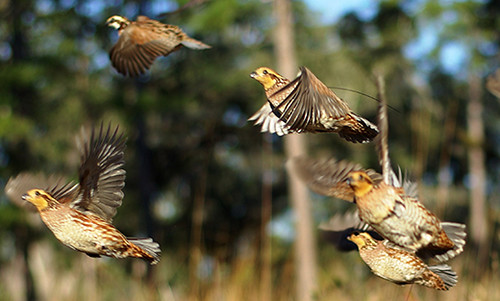
by Rick O'Connor | Dec 13, 2019
‘Bobwhites in Pine Savanna’ Workshop Set
For Jan. 30 in Marianna, Florida
The National Bobwhite Conservation Initiative (NBCI) and partners will host the Tri-State Bobwhite Symposium for professional land managers and landowners Thursday, January 30, 2020, in Marianna, FL.
It is the second Working Lands for Wildlife–Bobwhites in Pine Savanna workshop funded by the Natural Resources Conservation Service and is expected to draw attendees from three states. The program goal is to restore pine savanna on 82,000 acres across seven states using thinning, prescribed fire, and native grass restoration. Federal funding is available to landowners who choose to pursue pine savanna management on that designated landscape.
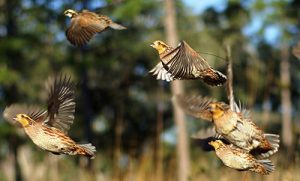
Bobwhite quail are popular with many hunters and management is trying to restore them.
Photo: USDA
“Private lands are a critical and necessary component for landscape-scale restoration of wild bobwhites, which is what NBCI is all about,” said NBCI Forestry Coordinator Steve Chapman. “Active management of pine forests on those lands, while still meeting landowner objectives, is a key NBCI strategy, and 82,000 managed acres will show the dividends of this approach.”
Dr. Jess McGuire, Quail Forever’s Working Lands for Wildlife bobwhite coordinator, added that “in order to achieve this level of restoration, wildlife professionals must be trained in the nuances of bobwhite management.”
The workshop will be from 9am–2pm at the University of Florida, Institute of Food and Agricultural Sciences (UF/IFAS) office, located at 2741 Penn Avenue, Suite 3, Marianna, FL 32448. Preregistration by January 23 is required by contacting jmcguire@quailforever.org or online at http://bit.ly/tristatequail.
Additional partners include Quail Forever, Florida Fish and Wildlife Conservation Commission, Tall Timbers Research Station and Land Conservancy, University of Florida Extension, and the Natural Resources Conservation Service.
Through multiple agreements, NBCI, in collaboration with Quail Forever and Warnell School of Forestry and Natural Resources/University of Georgia, will provide at least one of these workshops in each of the seven states identified in the project geography. Those states include Alabama, Florida, Georgia, New Jersey, North Carolina, South Carolina, and Virginia. Partners will also produce educational materials detailing management techniques and the results of intentional, targeted pine savanna management for bobwhites as part of the overall project.
About NBCI
Headquartered at the University of Tennessee’s Institute of Agriculture/Department of Forestry, Wildlife and Fisheries, NBCI is a science and habitat-based initiative of the National Bobwhite Technical Committee (NBTC) to elevate bobwhite quail recovery from an individual state-by-state proposition to a coordinated, range-wide leadership endeavor to restore wild bobwhites on a landscape scale. The committee is comprised of representatives of 25 state wildlife agencies, various academic research institutions and private conservation organizations. Support for NBCI is provided by the Federal Aid in Wildlife Restoration Program, state wildlife agencies, the Joe Crafton Family Endowment for Quail Initiatives, the University of Tennessee, Park Cities Quail and Roundstone Native Seed.
Contact:
John Doty
Communications Director
(865) 974-7281

 Beginning in 2007 the US Senate, in support of the North American Pollinator Protection Campaign, declared the last week of June as “National Pollinator Week.” As humans, we depend on pollen-moving animals for one out of every three bites of food. Without birds, bees, bats, beetles, butterflies, and various other animals, many flowers would fail to reproduce. In Florida there are numerous native plants that serve as hosts for these pollinators.
Beginning in 2007 the US Senate, in support of the North American Pollinator Protection Campaign, declared the last week of June as “National Pollinator Week.” As humans, we depend on pollen-moving animals for one out of every three bites of food. Without birds, bees, bats, beetles, butterflies, and various other animals, many flowers would fail to reproduce. In Florida there are numerous native plants that serve as hosts for these pollinators. It is a semi-aquatic woody shrub to small tree that develops white golf-ball-sized clusters of fragrant flowers, attracting various pollinating animals. Bees of various species, several different wasps, assorted moths and butterflies, flies and even hummingbirds scramble for the flowers’ sweet treat within each of the trumpet shaped flowers. The pincushion-like flower balls stand on two inch stalks in clusters arising from stem tips and leaf axils. They are produced over a long period in late spring and summer. The flowers give way to little reddish-brown nutlets which persist on the through the winter. Buttonbush seeds are important wildlife food, especially for ducks; and the dense, impenetrable tickets provide nesting and escape cover for many wetland birds and herptiles. Buttonbush is a fast-growing wetland plant that can be grown in a naturalized landscape if given supplemental water during dry spells. It is at its best, through, in an area where the soil is frequently wet and can tolerate soggy soils. Buttonbush is not drought or salt tolerant. The deciduous shrub grows well in full sun to partial shade on soils that are acidic to slightly alkaline. The leaves of Buttonbush turn yellow in the fall before dropping off. While short-lived, requiring rejuvenation pruning to improve its longevity, Buttonbush (Cephalanthus occidentalis) serves a critical role to wildlife in the wetland habitat. Deer browse the foliage and twigs. Ducks, especially the mallard, eat the seeds. And, the summer flowers attract bees, butterflies and moths; our wonderful pollinators.
It is a semi-aquatic woody shrub to small tree that develops white golf-ball-sized clusters of fragrant flowers, attracting various pollinating animals. Bees of various species, several different wasps, assorted moths and butterflies, flies and even hummingbirds scramble for the flowers’ sweet treat within each of the trumpet shaped flowers. The pincushion-like flower balls stand on two inch stalks in clusters arising from stem tips and leaf axils. They are produced over a long period in late spring and summer. The flowers give way to little reddish-brown nutlets which persist on the through the winter. Buttonbush seeds are important wildlife food, especially for ducks; and the dense, impenetrable tickets provide nesting and escape cover for many wetland birds and herptiles. Buttonbush is a fast-growing wetland plant that can be grown in a naturalized landscape if given supplemental water during dry spells. It is at its best, through, in an area where the soil is frequently wet and can tolerate soggy soils. Buttonbush is not drought or salt tolerant. The deciduous shrub grows well in full sun to partial shade on soils that are acidic to slightly alkaline. The leaves of Buttonbush turn yellow in the fall before dropping off. While short-lived, requiring rejuvenation pruning to improve its longevity, Buttonbush (Cephalanthus occidentalis) serves a critical role to wildlife in the wetland habitat. Deer browse the foliage and twigs. Ducks, especially the mallard, eat the seeds. And, the summer flowers attract bees, butterflies and moths; our wonderful pollinators.






















